Roti


Roti (Hindi: रोटी ; Punjabi: ਰੋਟੀ ; Urdu: روٹی ; Gujarati: રોટલી ; IPA: [ro:ʈi]) is the word for bread in Hindi, Urdu, Punjabi, Pashto, Indonesian, Malay, Bengali, and Somali .
Indian
Roti is the traditional Indian bread, normally eaten with curries or cooked vegetables. It is made most often from wheat flour, cooked on a flat or slightly concave iron griddle called a tawa. It is similar to a tortilla in appearance. Like breads around the world, roti is a staple accompaniment to other foods, maybe spread with ghee (clarified butter) or yoghurt.
Outside South Asia
Indonesia, Malaysia and Thailand
In Indonesia and Malaysia the term encompasses all forms of bread including western-style bread as well as the traditional punjabi breads.
In Thailand, "roti" refers to the maida paratha—known in Malaysia as roti canai and in Singapore as roti prata—which is typically drizzled with condensed milk, rolled up, and eaten as a hot snack.
West Indian
Roti also features prominently in the diet of many West Indian countries, especially Trinidad and Tobago, Guyana, Grenada, Saint Vincent and the Grenadines and Suriname. West Indian roti are primarily made from wheat flour, baking powder,salt, and water and cooked on a tava. Certain rotis are also made with butter. There are several types of roti made in the West Indies.
Trinidad and Leeward Islands
- Sada Roti: This is a plain roti, made of white flour. Because it is the simplist roti to make, it is the most commonly consumed roti in Trinidad. It is a popular breakfast option in Trinidad, in combination with tomato choka, baigan choka (eggplant), and other vegetable dishes.
- Paratha Roti: A roti made with butter, usually ghee. It is cooked on a tava. Oil is rubbed on both sides, then it is fried. This gives the roti a crisp outside. When it almost finished cooking, the cook begins to beat the roti while it is on the tava, causing it to crumble. It is also called 'Buss-Up-Shut' in Trinidad.
- Dosti Roti: A roti where two layers are rolled out together and cooked on the tava. It is also rubbed with oil while cooking. It is called dosti roti because the word dosti means friendship in Hindi. This type of roti is eaten in Guyana with a special halva when a child is born.
- Dhalpuri: A roti with a stuffing of ground yellow split peas, cumin (geera), garlic, and pepper. The split peas are boiled until they are al dente and then ground in a mill. The cumin is toasted until black and also ground. The stuffing is pushed into the roti dough, and sealed. When rolled flat, the filling is distributed within the roti. It is cooked on the tava and rubbed with oil for ease of cooking. This is the most popular roti.
Guyana
Depending on where Indians settled in Guyana foods can be different. Indo-Guyanese food as a whole can be different from their Trinidadian brothers, including the names of many items.
- A small amount of fat is placed in each piece of dough before it is rolled out to make the roti softer. Usually Vegetable oil is used, but butter, or margarine can also be used. Ghee is not used in everyday Guyanese cooking, and is only used by the Hindus on religious occasions. The Roti is usually clapped by hand or beaten a bit, hot off the tava, so it softens but does not break.
- A good roti in Guyana is one that is very soft, with layers (almost like pastry layers if possible), which remains whole. If the roti is dry, rough, hard, or is broken up, it's indication the that individual does not know how to make roti (or extrapolated into not knowing how to cook), and will be laughed out of the kitchen.
- Depending what is placed in the dough before it is rolled out, that is the type of roti one gets. Various types include Dhalpuri, potato roti, and even sugar(to keep the kids busy, while the mother finishes cooking).
- Among the Indo-Guyanese, a rolled out dough that is deep fried in ghee is called a puri, and is only made for Hindu religious gatherings. Therefore a Dalpuri is not really a puri, as a puri and a roti are two different things.
- Bake: Another item prepared like roti is bake or bakes or floats. Dough is rolled out and cut into shapes or rolled into small rounds. Guyanese bakes or floats are fried, but bakes from other parts of the West Indies can can be baked in an oven. They are sometimes called frybake. Bake are usually paired with a fryup for breakfast or dinner, or with stewed saltfish. Bakes is also made in other parts of the West Indies including Trinidad, Barbados and St. Vincent.
Other dishes
The word 'roti' in the West Indies may also refer to a dish of stewed or curried ingredients wrapped in a 'roti skin'. In Trinidad and Tobago various rotis are served. Popular variations include chicken, conch, beef and vegetable. Shrimp and goat are available. The term is used locally in cities with large West Indian populations, such as Brooklyn, Toronto and Montreal.
While common variations may include chicken, beef, or cabbage and carrot, one of the more authentic alternatives (goat) is known as Groti.
In Suriname roti refers also to a dish of stuffed and spiced roti wraps. Due to mass emigration of Surinam Hindustani in the 1970's, roti became a popular take-out dish in The Netherlands. It usually includes chicken, potatoes, boiled eggs and various vegetables, most notably the kousenband or yardlong bean. Another variation includes shrimp and aubergine. It is custom to eat the dish by hand.
External links
- How To Cook Roti (youtube)
- Cauliflower Roti Recipe at Click2Cook
- How to make Roti Video Recipe
- Rotiboy
- [http://www.stabroeknews.com/index.pl/article_affairs?id=56515777 Article on various
Caribbean bakes]
